This document discusses the need for new models of prosperity and capitalism in response to global crises characterized by 'wicked' and 'super-wicked' problems. It emphasizes the transition from 'thin value' to 'thick value' creation and highlights the role of wisdom traditions and holistic approaches in fostering sustainable business practices. By integrating insights from diverse cultures, the document proposes principles that could guide organizations towards more conscious and responsible operations.
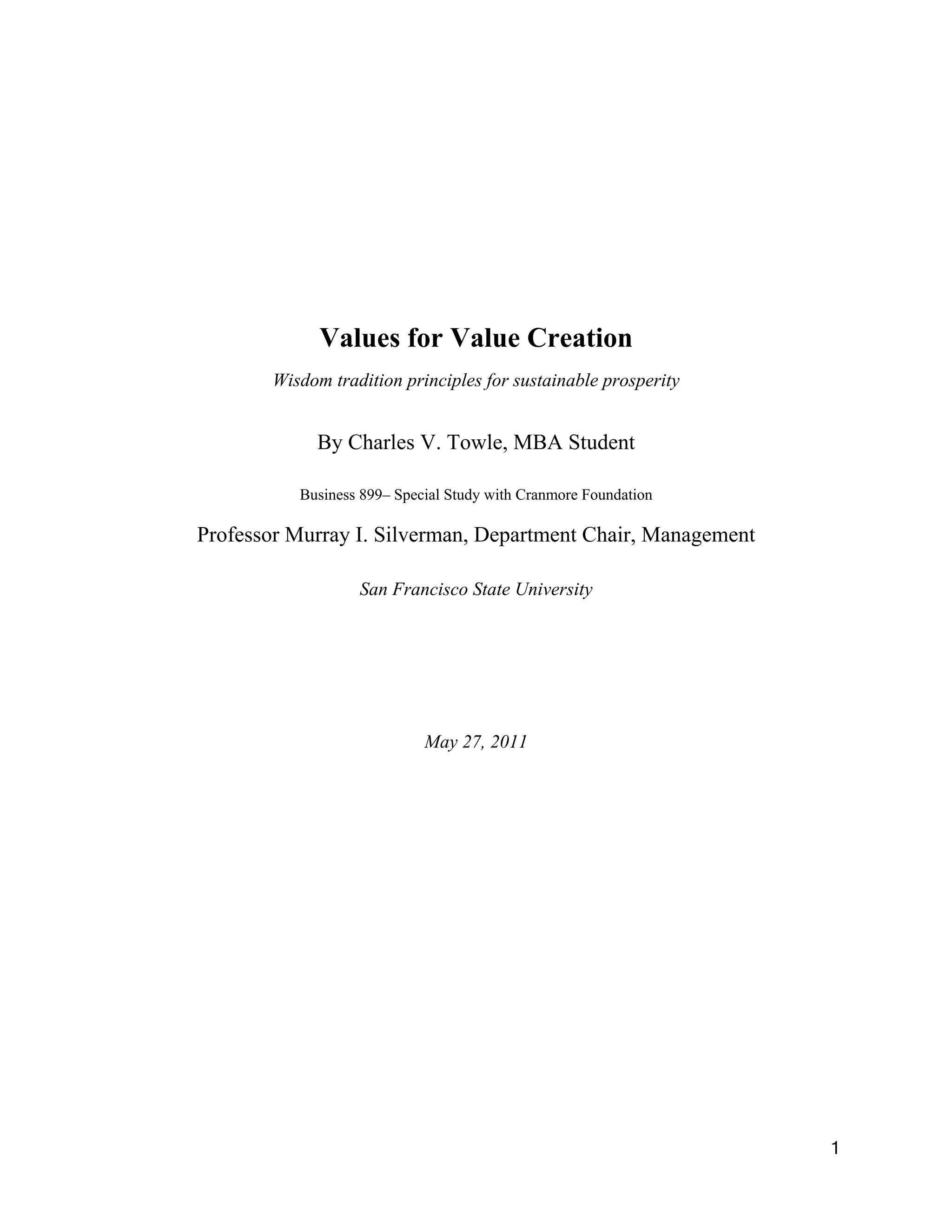
![Introduction
Crisis and ambiguity
Global systems are in crisis. Despite significant gains in science, technology and
management know-how, the world is confronted by a breakdown of financial, business,
governmental, societal and ecological systems. All of this presents us with a new order of
complexity. In an era where “discontinuity is the only constant” leaders are in need of a different
quality of solution if they are to successfully meet the challenges ahead. (Nonaka & Tekeuchi)
Information and the speed of access to data is not enough. “All the knowledge in the world did
not prevent the collapse of the global financial system”. (Haque, Umair) It seems that our
modern global culture has arrived at a place where “the ability to lead wisely has nearly
vanished”. (Ibid)
This unprecedented crisis raises questions even about the future viability of capitalism as
we know it. Paul Samuelson in the New Perspectives Quarterly (2009) posits that “today we see
how utterly mistaken was the Milton Friedman notion that a market system can regulate itself”.
(Ibid) It seems that Adam Smith’s notion of the market’s self-regulating “invisible hand”
deserves a new scrutiny when Alan Greenspan comments that “the whole intellectual edifice” of
financial economics “collapsed in the summer [of 2008]”. (Ibid) The causes of this crisis can be
attributed to “wicked problems”. (Rittel & Webber)
In simple terms “wicked problems” can be described as unique and difficult to define – in
fact they are often not understood until after a solution is formulated. (Ibid) Further, they: have
no stopping rule; are neither true nor false but better or worse; they can be symptomatic of other
problems; and their solution is a ‘one shot’ operation due to constraints that do not allow trial
and error. In recognising the “wicked problem” nature of the current crises, Barack Obama’s
chief economic advisor and former Harvard President Larry Summer said that “large swaths of
economics are going to have to be rethought”. (Haque, Umair) Furthermore, the complex
structure of global systems contributes to the creation of “super-wicked problems” (Lazarus &
Richard) which have the additional conditions where: there is no central authority; time is
2](https://image.slidesharecdn.com/valuesforvaluecreation-120509054644-phpapp01/75/Values-for-Value-Creation-2-2048.jpg)
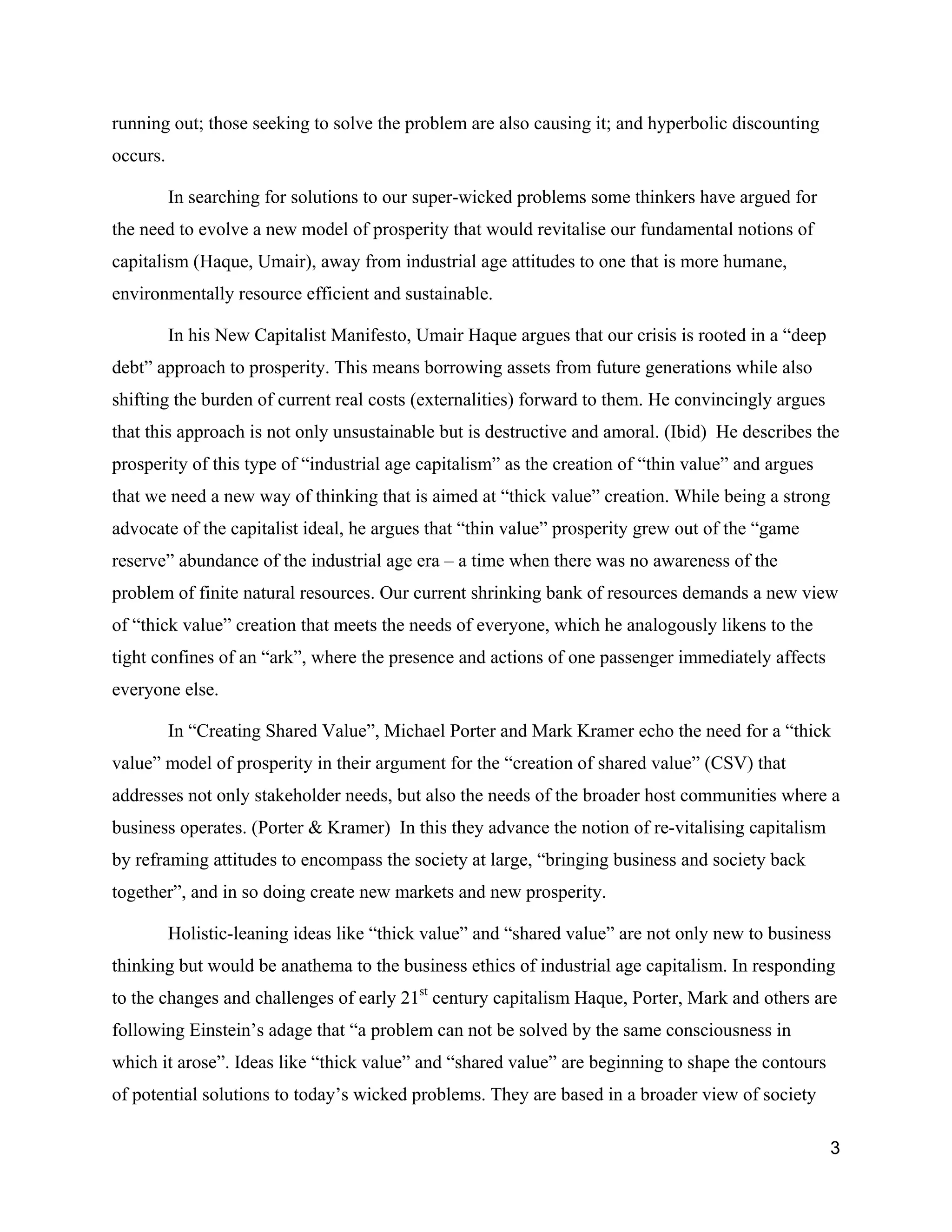
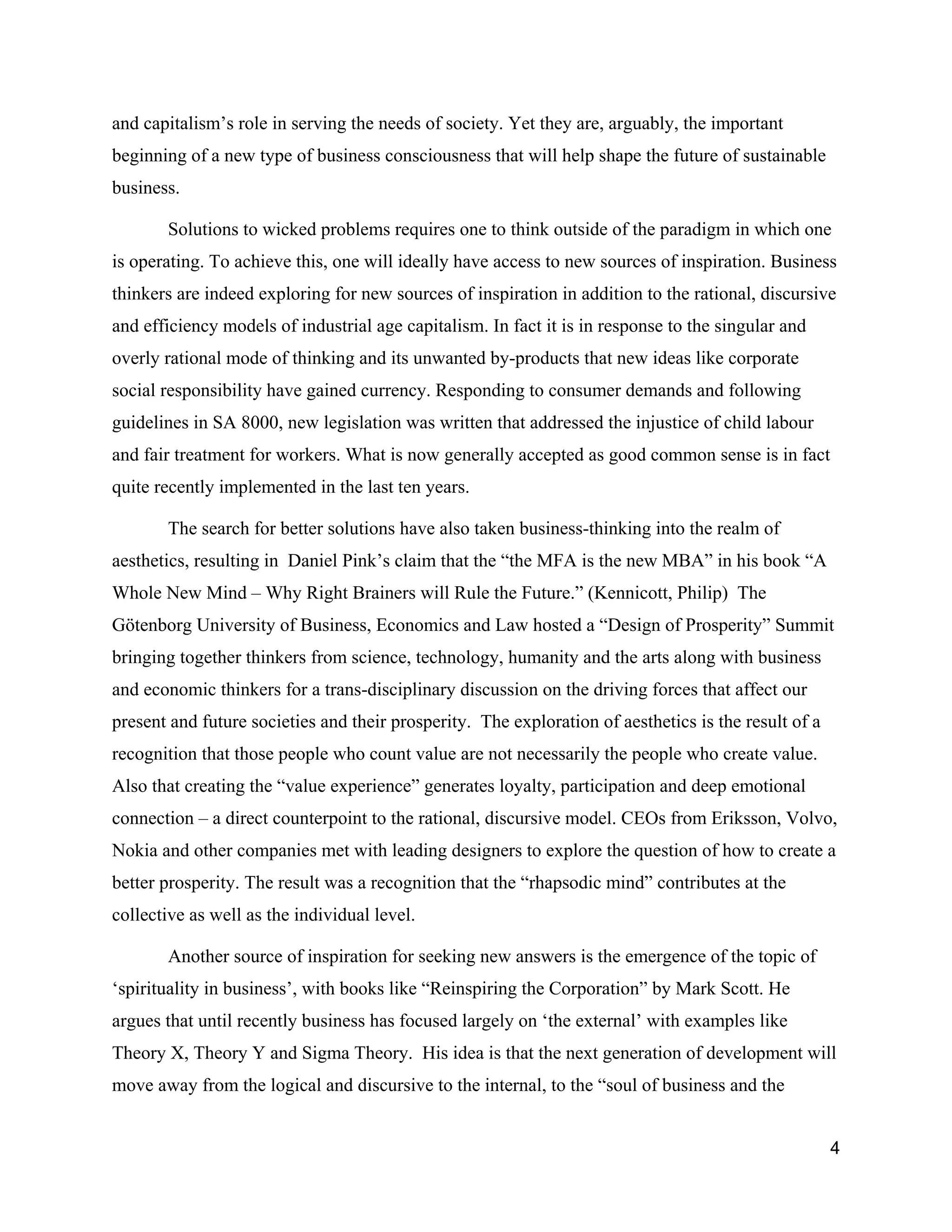
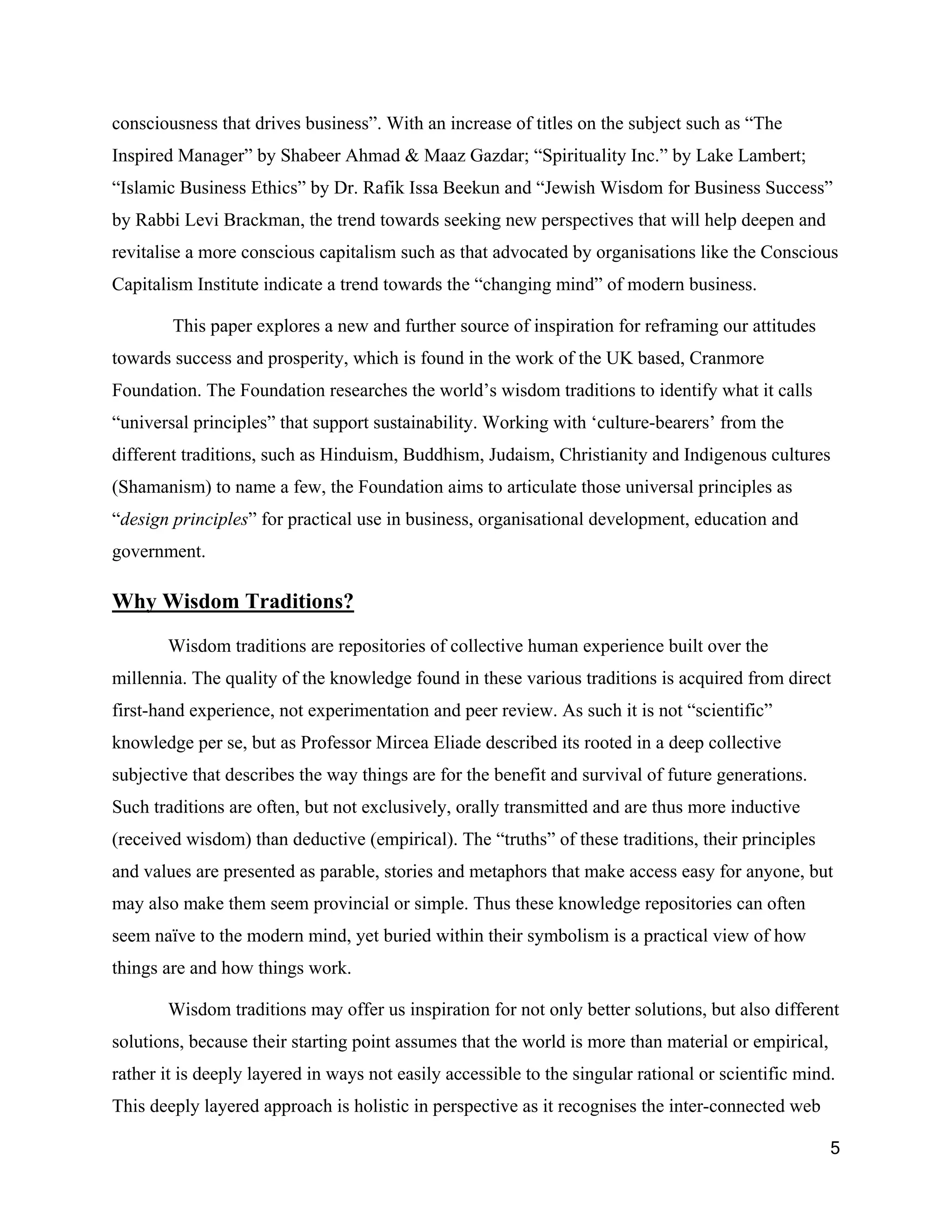
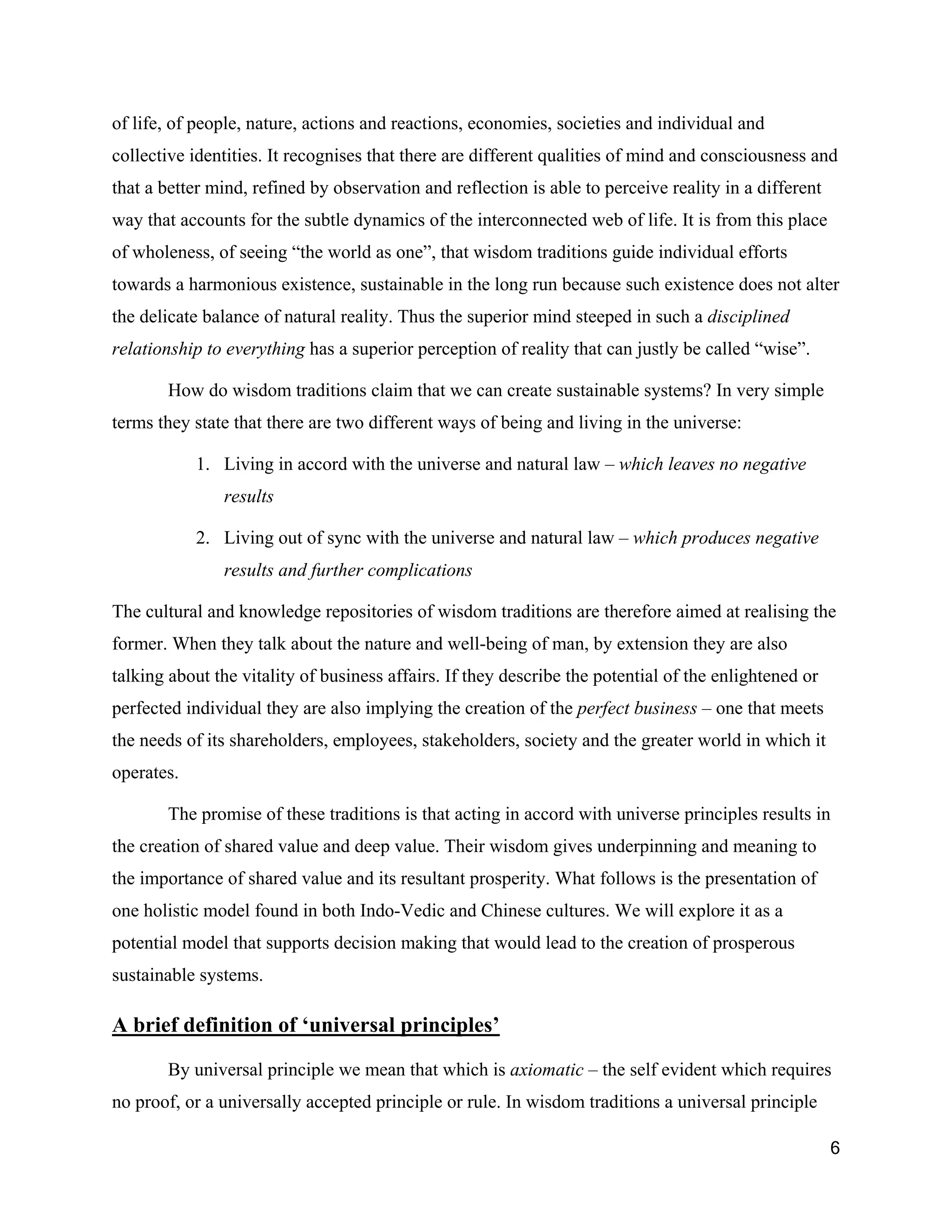
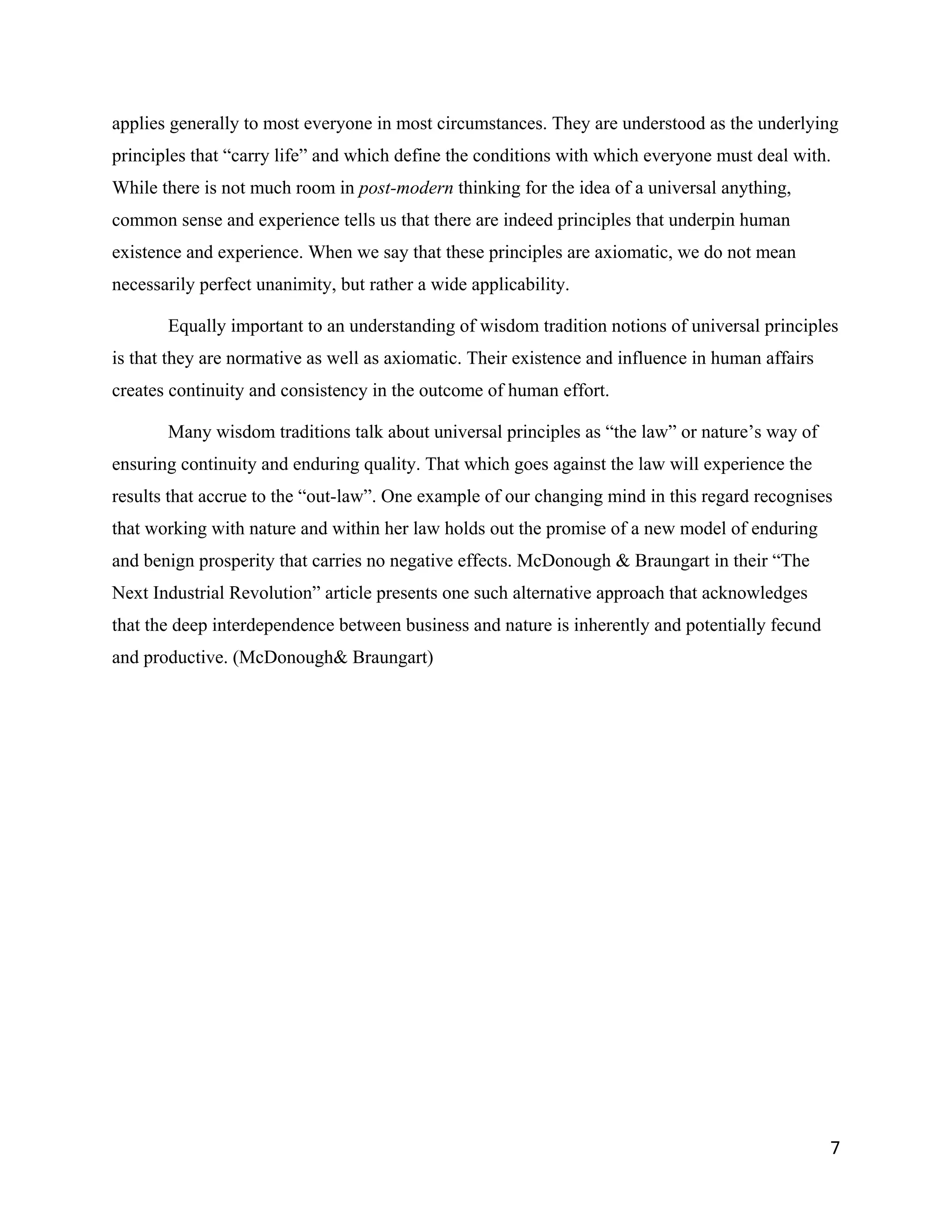
![Three Approaches to Business - Expanding our Frame of Reference
Wisdom traditions begin by seeking to expand the frame of reference of the individual by
degrees, away from the selfish and narcissistic, to encompass a more broad minded perspective
that recognises one’s essential role within the greater whole. They create context by expanding
one’s frame of reference to account for factors outside of one’s self, such as others, society,
nature and the world – even up to the idea of the universe itself.
In researching the Indo-Vedic wisdom tradition, Cranmore Foundation has identified
three perspectives or approaches defined which the Foundation describes as the Narrow, the
Broad and the Deep.
The Narrow approach can be described as ‘business as usual’, where the priority is short-
term profit at the expense of everything else. In this approach business is not concerned with the
long-term consequences of its actions — externalities like pollution, depleted natural resources
or adverse social impacts are not accounted for. This “thin value” (Haque, Umair) approach
works against the larger long-term interests of business by limiting its perception of opportunity.
This “narrow conception of capitalism has prevented business from harnessing its full potential
to meet society’s broader challenges”. (Porter, Michael & Kramer, Mark)
The Broad approach is symptomatic of the “superior mind” of a more conscious
individual or business. Such an individual accounts for its relationship with the world and is by
degrees more responsive and responsible to a larger circle of stakeholders than those taking the
narrow approach. Companies that take a broad approach invest in stakeholder relationship
management [SRM] programs (Sisodia, Wolfe & Sheth), CSR initiatives, humane partnering
approaches to their work force, and acknowledge their responsibility for the impact of their
externalities. Yet, the Broad approach does not guarantee a sustainable reality, something more is
required. (Hart, Stuart)
The Deep approach, according to the degree of its application, gives the perspective
needed to achieve genuine sustainability. It is characterised by a deep awareness of the
interconnected web of life and nature and operates consciously from a place of service, care and
contribution for the greatest possible good. It acknowledges the interests of an expanded set of
stakeholders and thinks of its good as non-different from the good of all. (Savitz & Weber) The
8](https://image.slidesharecdn.com/valuesforvaluecreation-120509054644-phpapp01/75/Values-for-Value-Creation-8-2048.jpg)
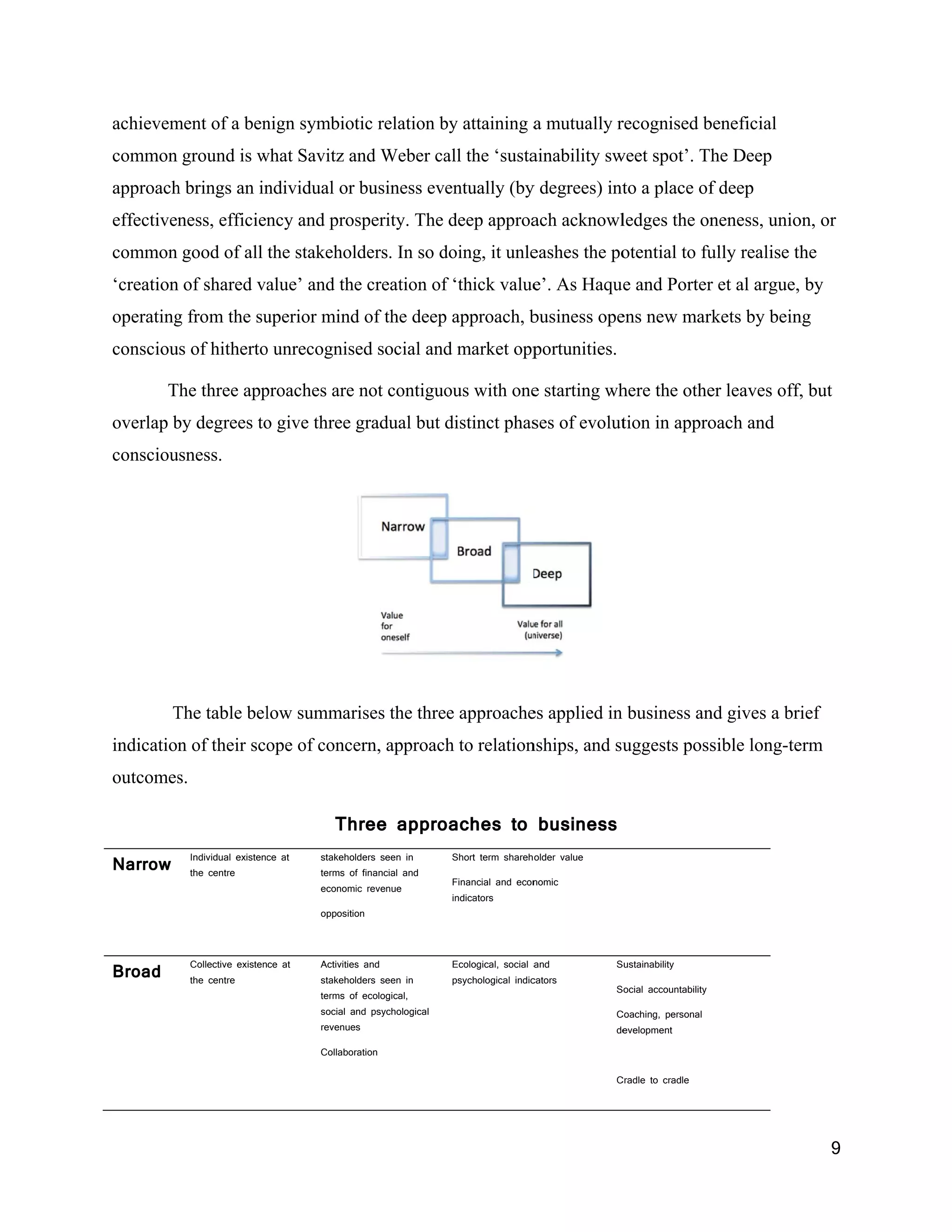
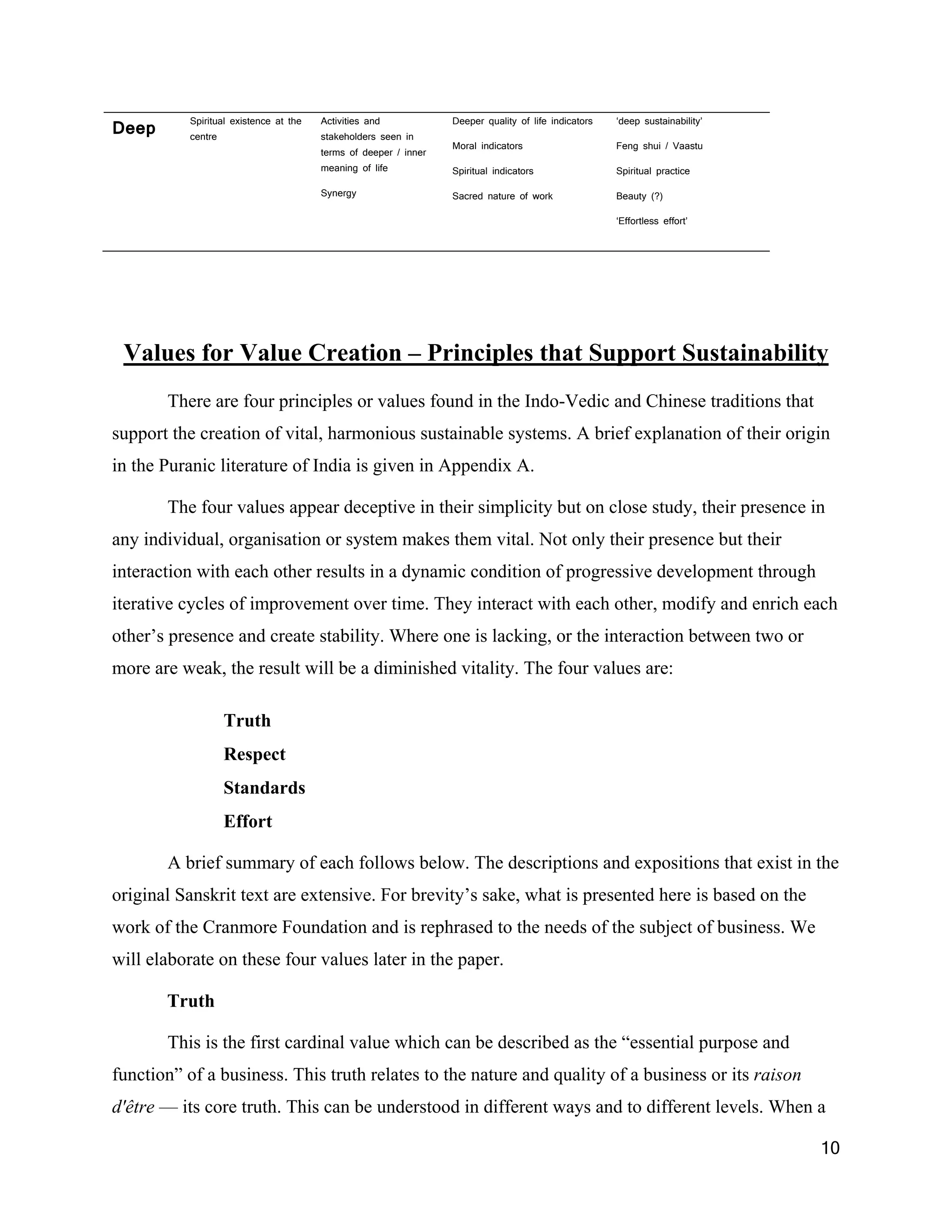

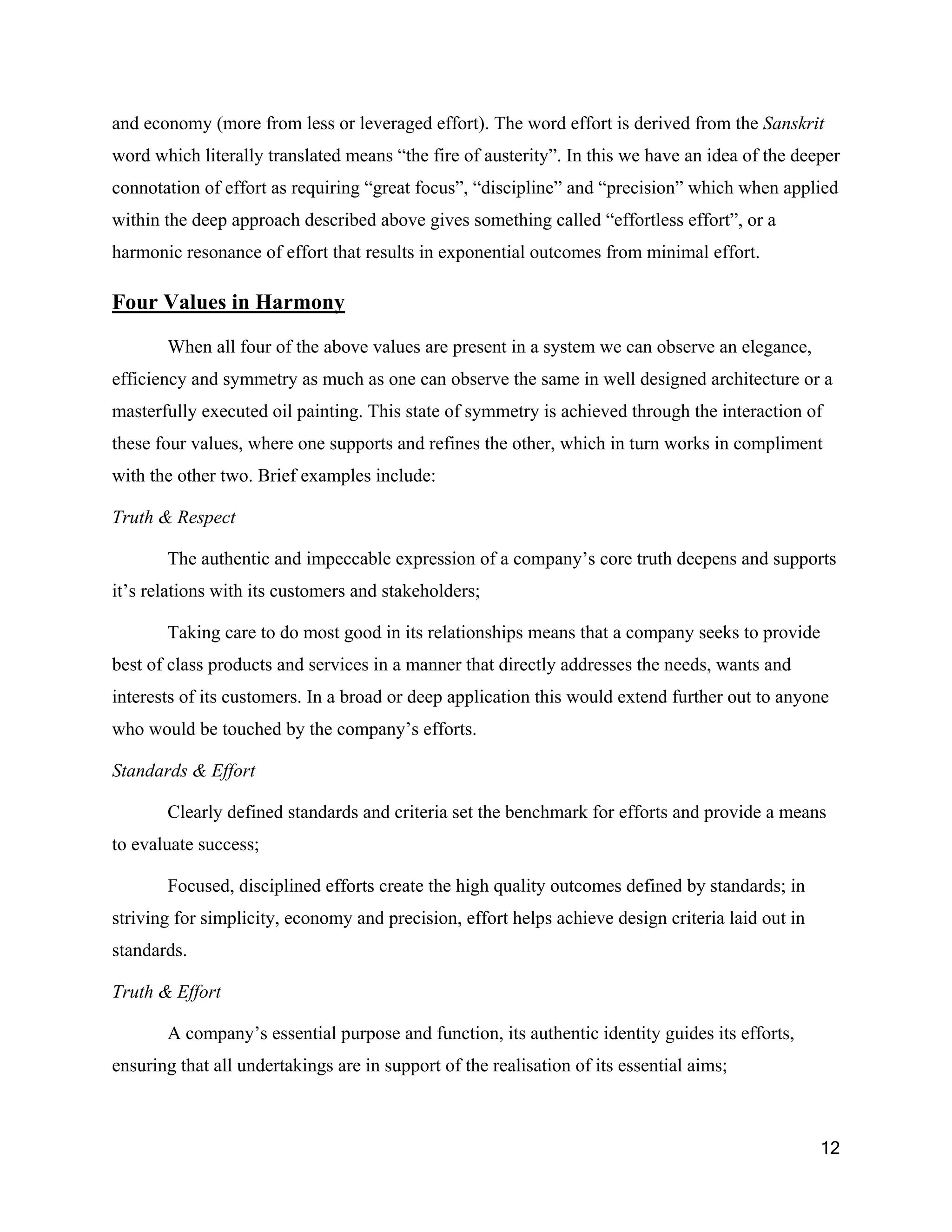
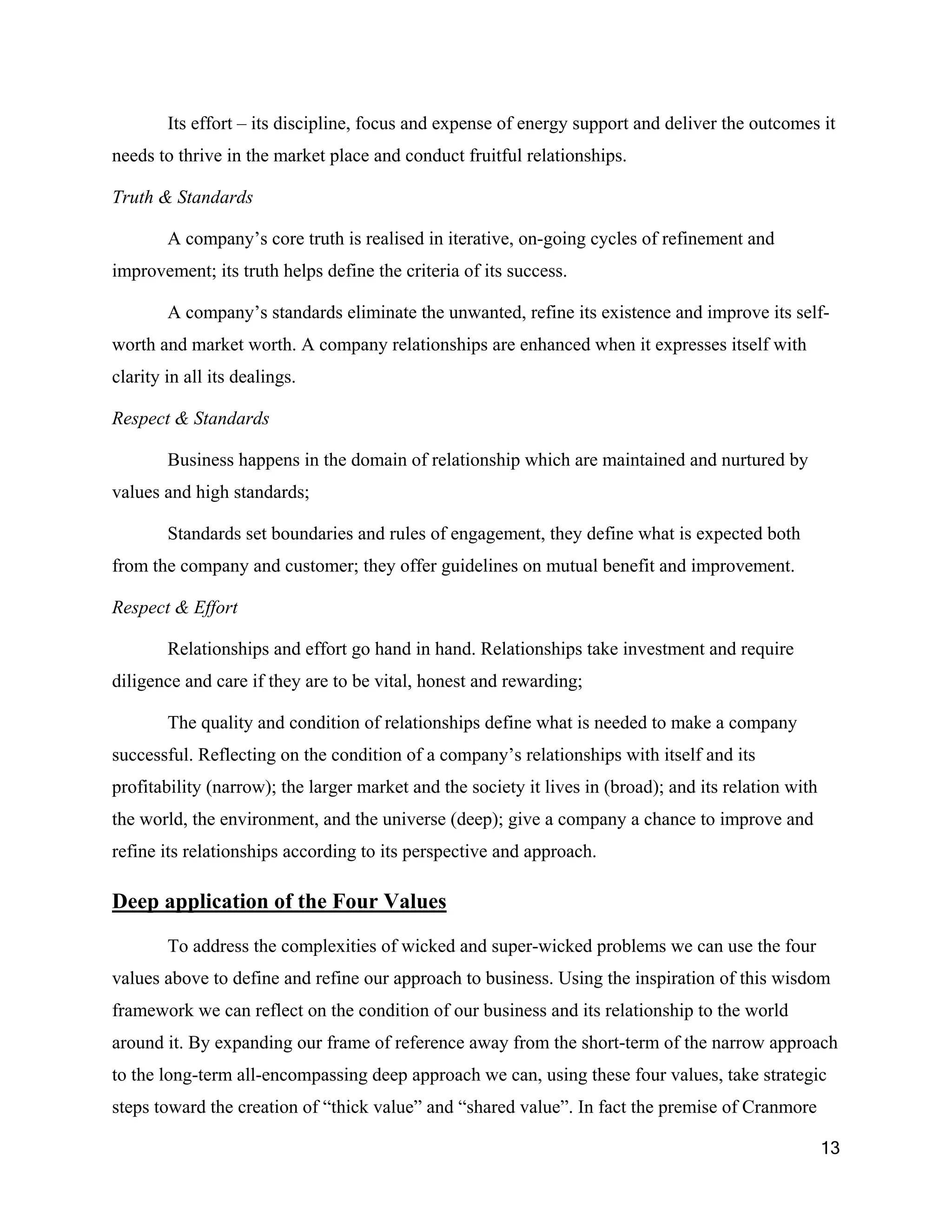
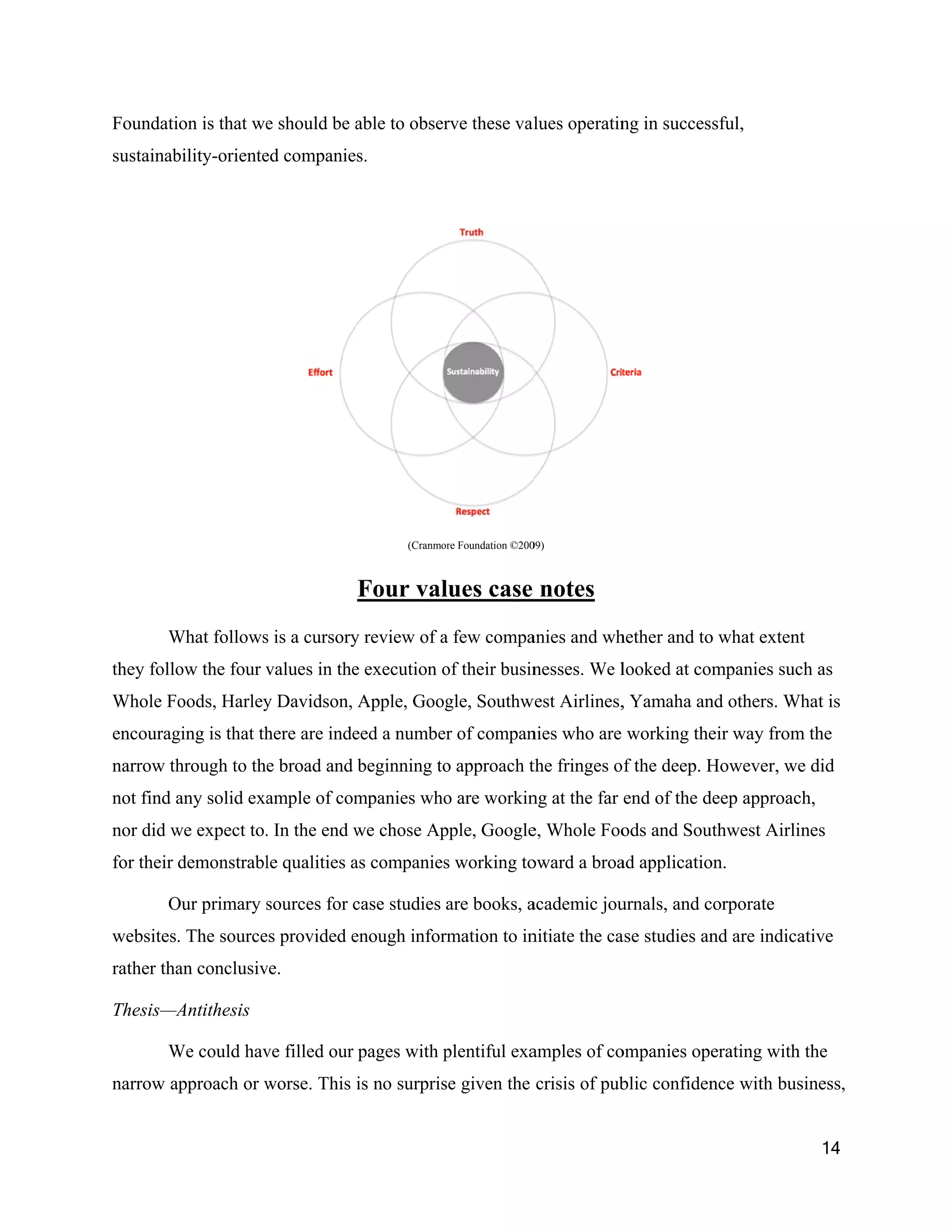
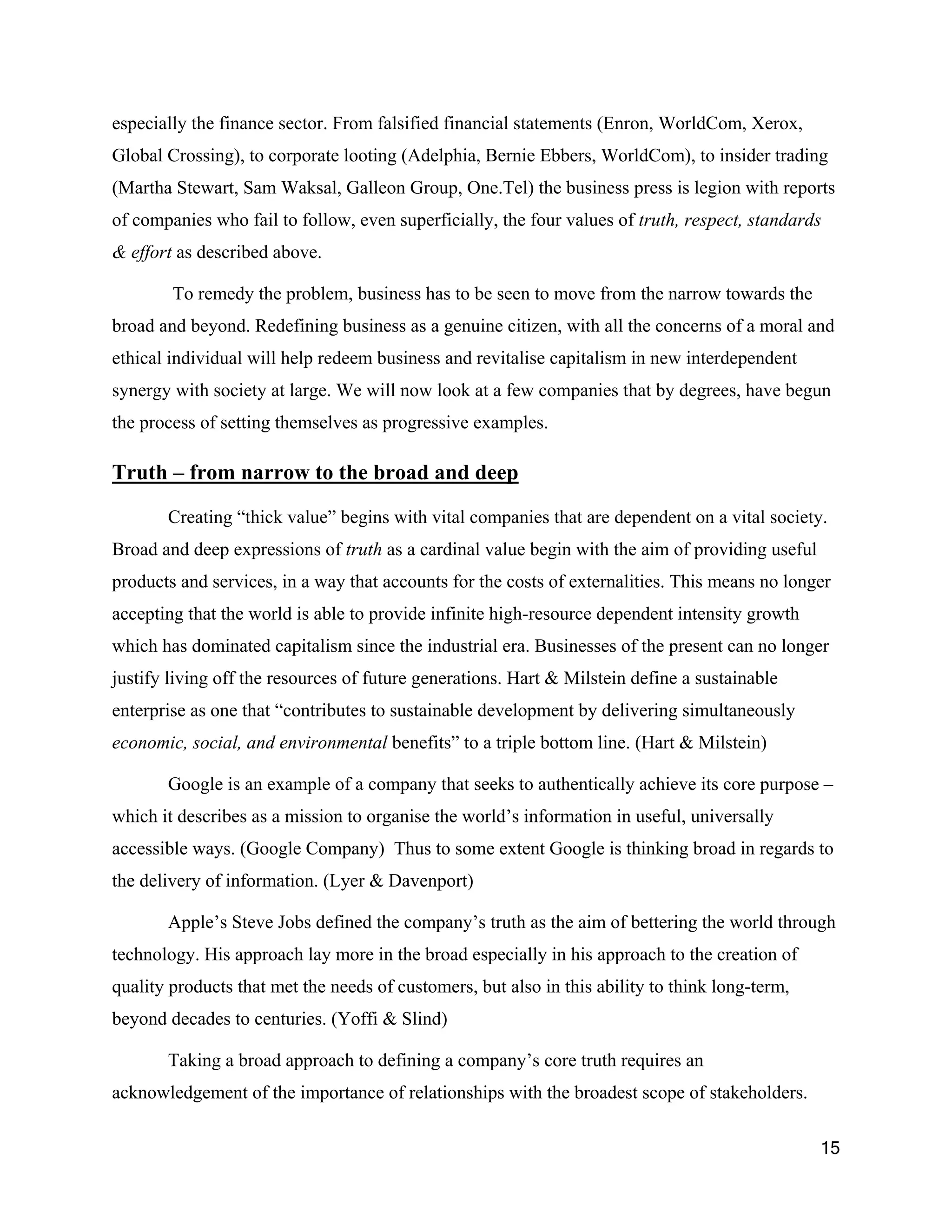
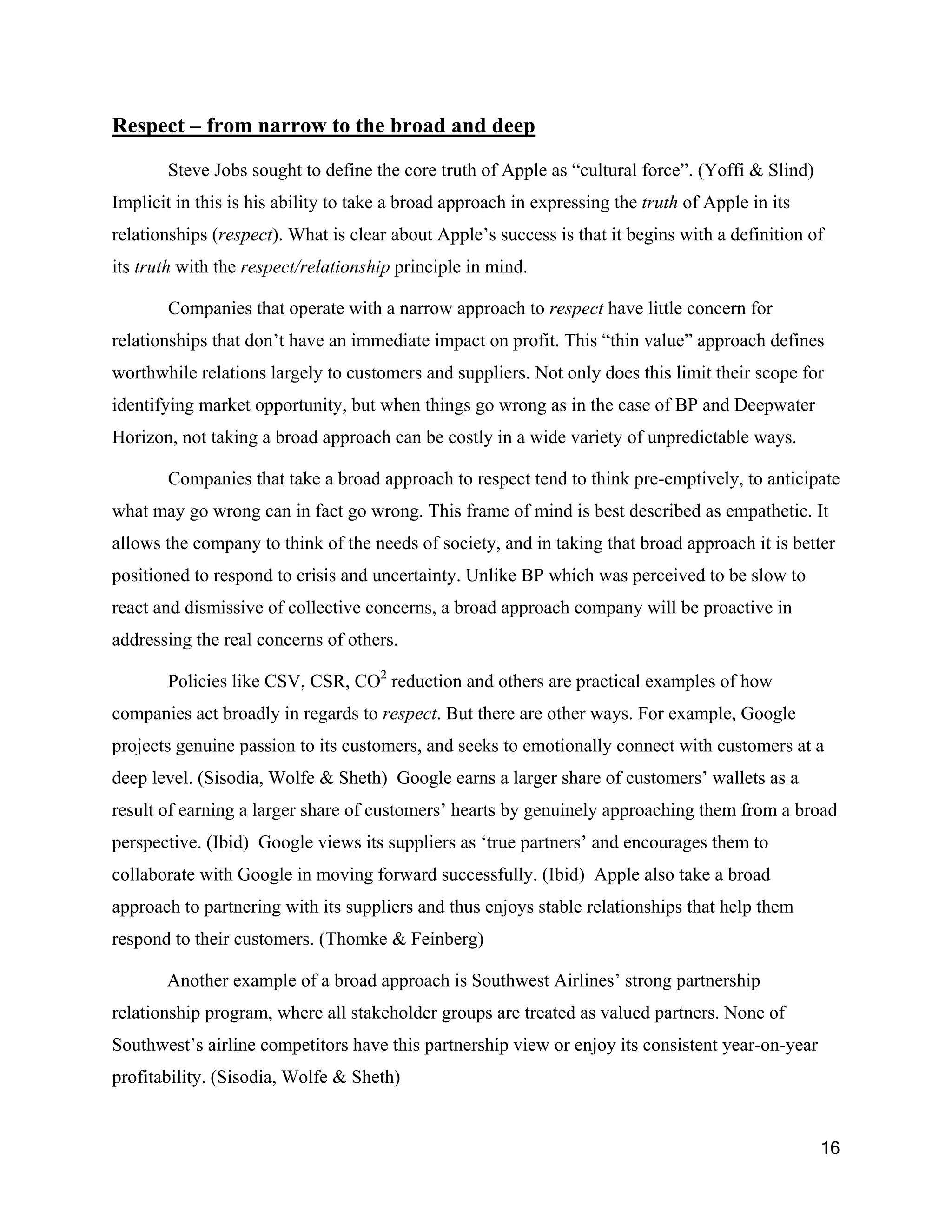
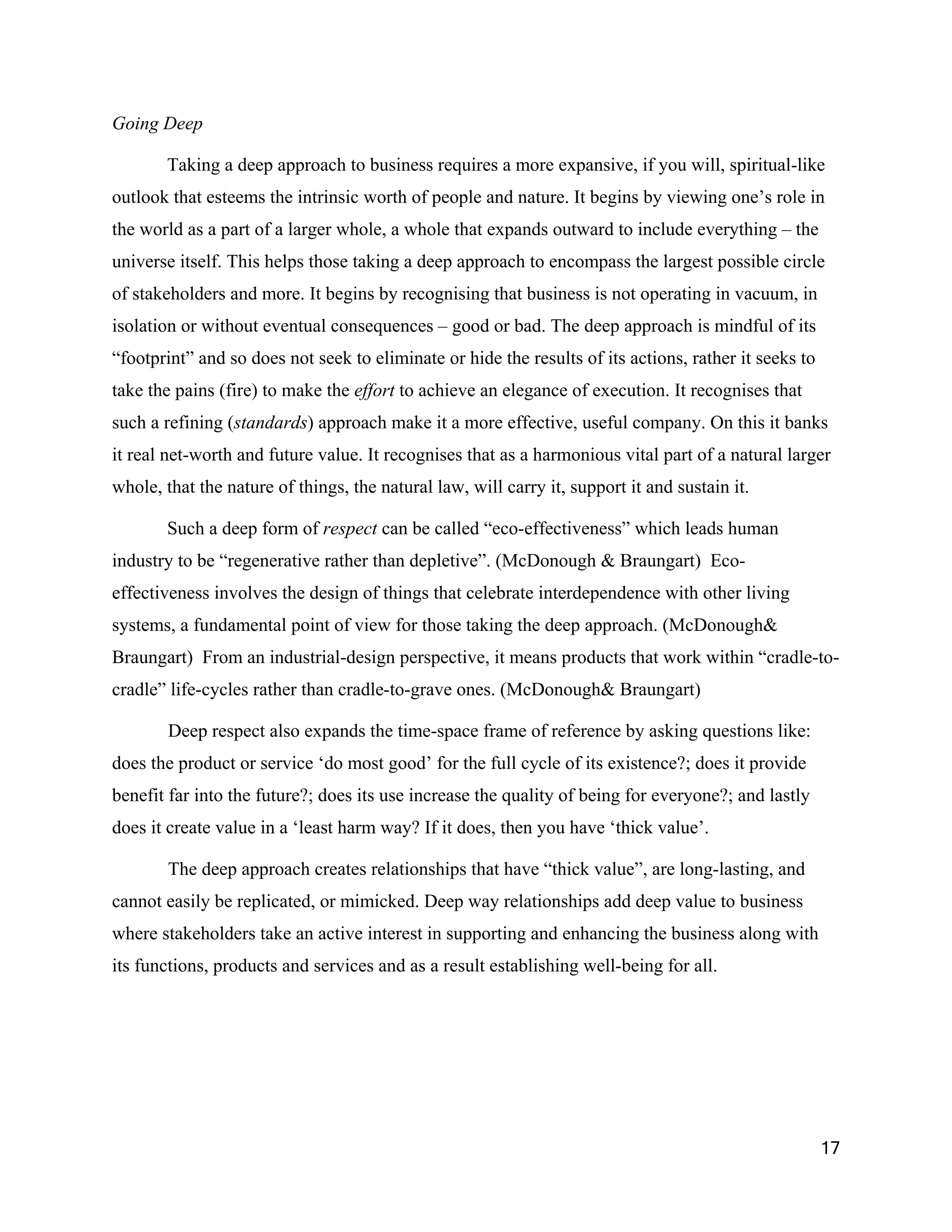
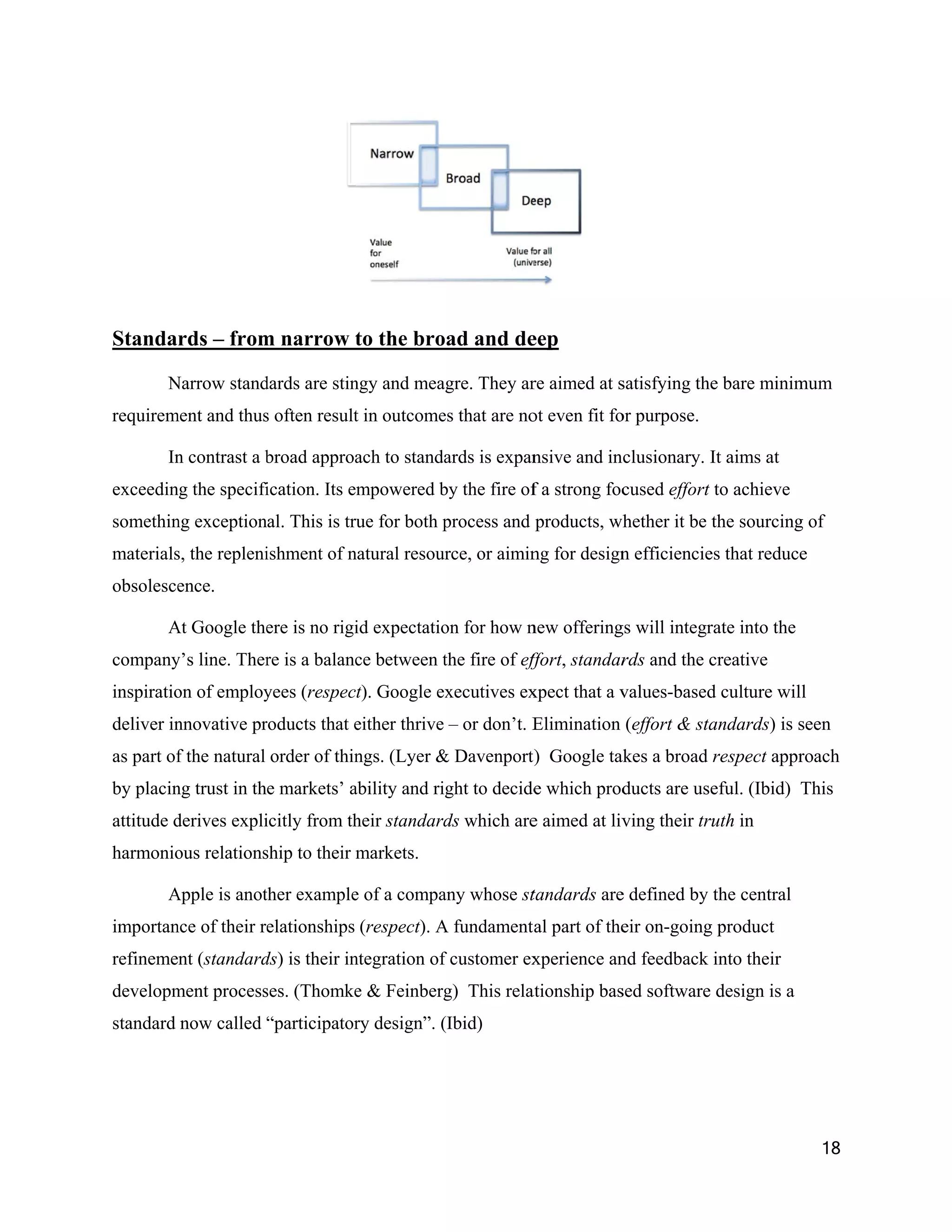


![A Case Study that demonstrates all Four Values
The foregoing highlights the application of the various values by Apple, Google and
Southwest. The premise of Cranmore Foundation is that companies that apply all four values as
part of holistic strategy should be demonstratively successful and sustainable, to the extent that
the four values are present and mutually supportive. What follows is the example of Whole
Foods, which appears to consciously apply these four values as part of their holistic strategy.
[Note: we do not make any claim that Whole Foods has consciously applied the model or
approach outlined in this paper, although we can conjecture that they may have been inspired at
least in part by wisdom tradition ideas].
Whole Foods articulates their core truth in their motto: “Whole Food, Whole People,
Whole Planet”. This statement identifies their essential purpose and function (truth); their
concern for their relationships and the contribution they aim to make to them; and notably their
broad (and potentially deep) approach to what they do. As such they begin with a broad
perspective which Sisodia, Wolfe and Sheth define as “a vision beyond being just a food retailer”.
Whole Foods demonstrates that their motto is not just a window-dressing mission
statement through their constant measurement of: customer satisfaction (respect); team member
excellence (standards) and satisfaction (respect); and larger extended community satisfaction
and support (respect). They affirm their core truth and build the basis for good employee
relations by hiring “foodies”. (Sisodia, Wolfe & Sheth) Their expressed aim to be an example of
“excellence for food retailers” (Ibid) articulates the high standards that define their company.
Further in their “‘Declaration of Interdependence’ (posted in every store and office) the company
acknowledges the idea that stakeholder groups constitute a family whose members depend on
one another” (respect) (Ibid). In aiming for this, the declaration acknowledges that it’s a
“dynamic process” that requires participation, …communication (respect), listening
compassionately, thinking carefully (standards) and acting with integrity (truth).
Whole Foods is committed to provide goods and services that improve its customer’s
lives (standards & respect); to provide jobs and meaningful work to employees (effort &
respect); and to create wealth and profits to its investors (respect, truth, standards & effort)
(Ibid) The company aims to meet all these concerns in a balanced manner through thoughtful
diligent effort.
21](https://image.slidesharecdn.com/valuesforvaluecreation-120509054644-phpapp01/75/Values-for-Value-Creation-21-2048.jpg)
![The company stays aligned to its core truth by keeping all four values alive and dynamic.
But does all this ‘happy-talk’ pay off? Or is it just ‘feel-good’? The numbers tell the real story of
sustainable prosperity delivered by Whole Foods.
Over the last ten years Whole Foods has proven to be a better bet for investors than any
of the five biggest grocers: Wal-Mart, Kroger, Albertsons, Safeway and Costco. Whole Foods
has returned 185% over the past three years, 400% over the past five (whereas the S&P 500 rose
by only 13%), and 921% over the last ten years. From December 1995 to June 2006 Whole
Foods returned over 1800%. By comparison “Wal-Mart has not added a nickel’s worth of value
to shareholder’s wealth in the past six years” [as at Feb 2007]. (Sisodia, Wolfe & Sheth)
Whole Foods demonstrates that a broad approach to value-creation pays off. The
company is a good example, but not the only one (Apple, Southwest Airlines, Costco, Commerce
Bank, etc.) of companies that are taking a different approach to sustainable value creation.
The question arises as to how companies working to the “thin value” model can “cross
over to other side”? In the pen-ultimate section of this paper, we will explore the possibilities for
applying these values to an existing company. How could a company use these four values as a
guide to achieve greater and sustainable profitability?
Values Creating Value – A hypothetical application
Meet Alpha Capital. Alpha is in the business of providing banking and financing
services to small and mid-cap businesses in the USA and Europe. Alpha addresses a part of the
market that is historically underserviced by big finance. It provides the same quality of
consultative advice, services and a variety of financing products that are geared to the unique
requirements of individual clients. The company is growing and its partners are thriving.
Alpha’s Truth
Alpha prides itself on “saying what they do and doing what they say”. In other words
they present themselves as straight-talking, if not blunt in their approach to dealing with
customers. In doing so, Alpha thinks that customers will value this candid approach and will
understand that such frankness is an expression of their respect for their relationships.
Alpha’s Respect
22](https://image.slidesharecdn.com/valuesforvaluecreation-120509054644-phpapp01/75/Values-for-Value-Creation-22-2048.jpg)


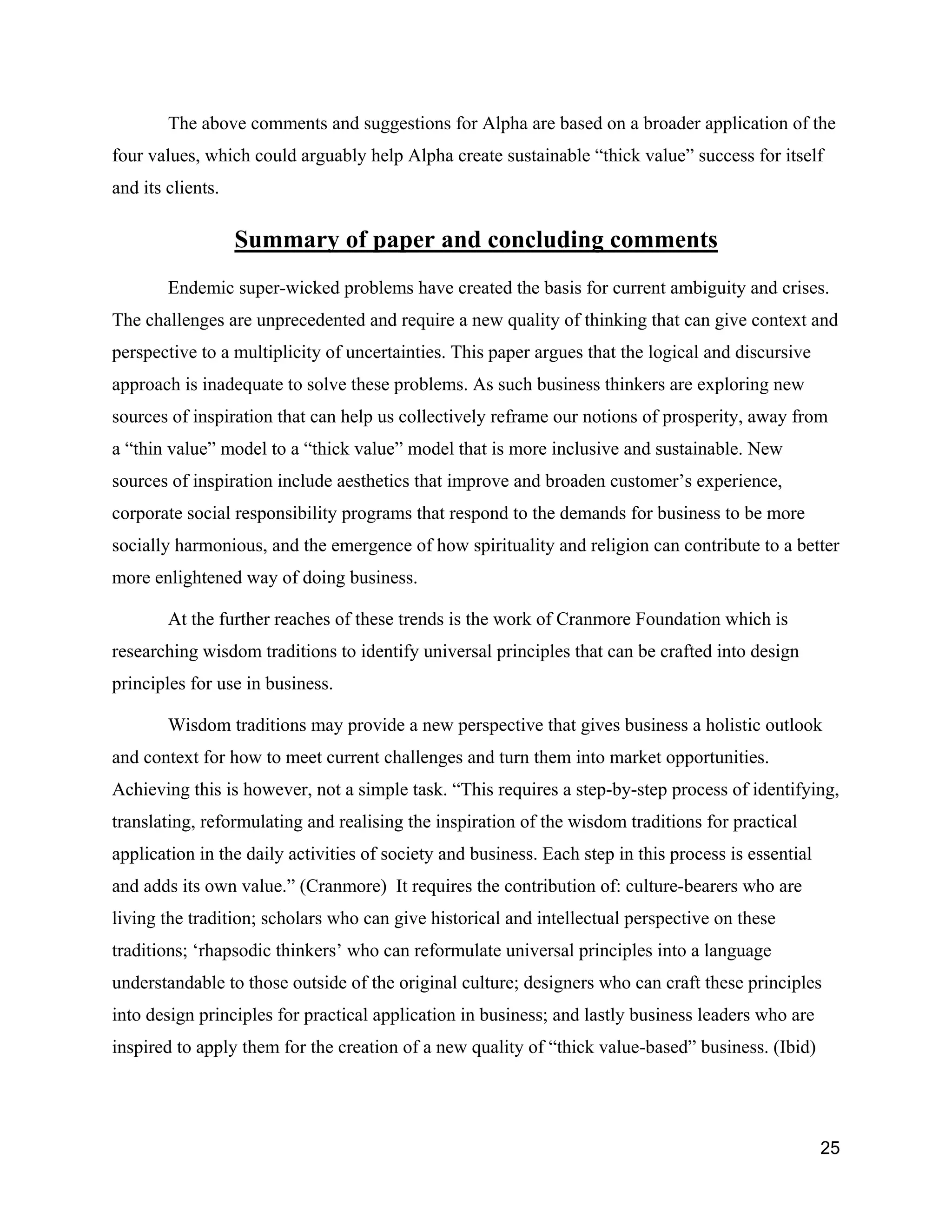
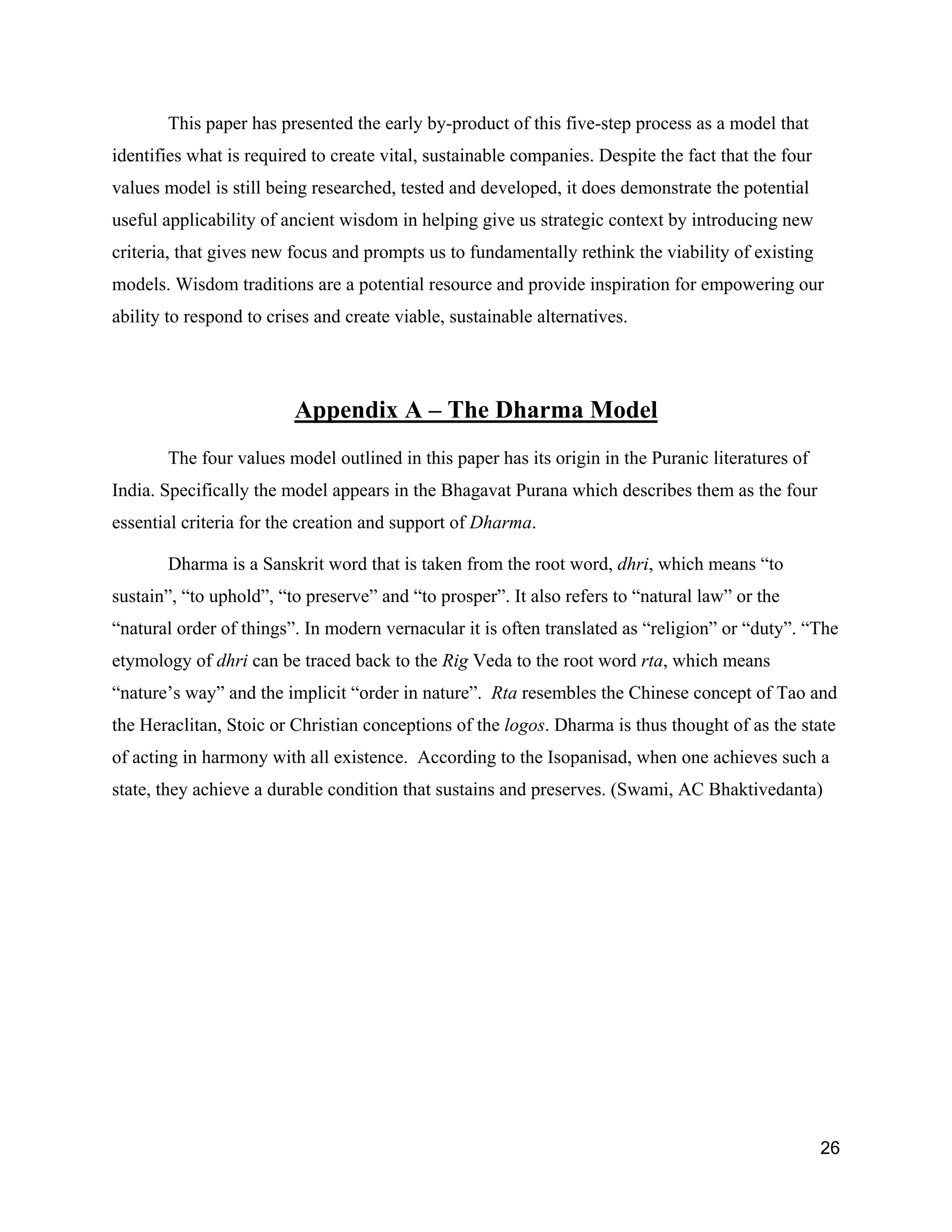
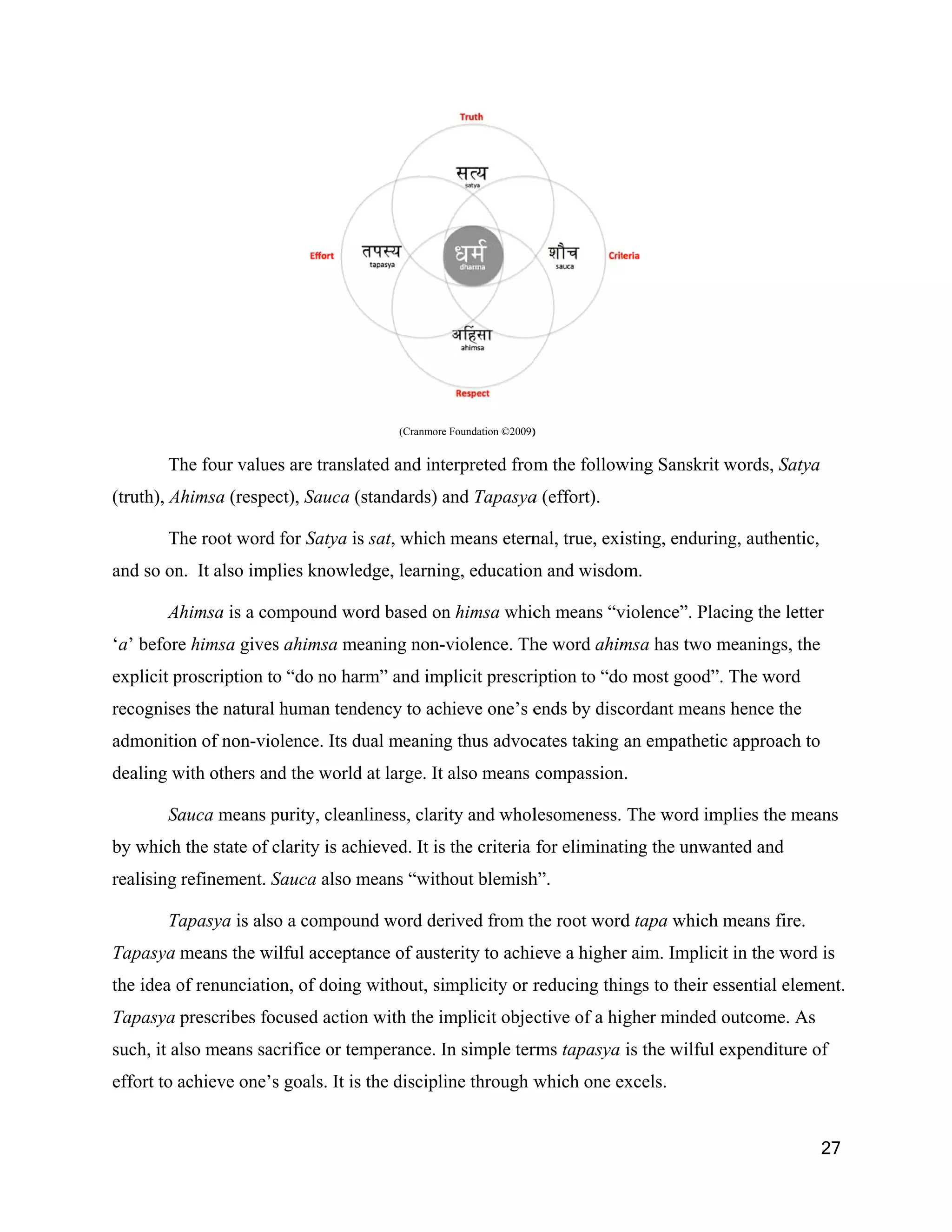
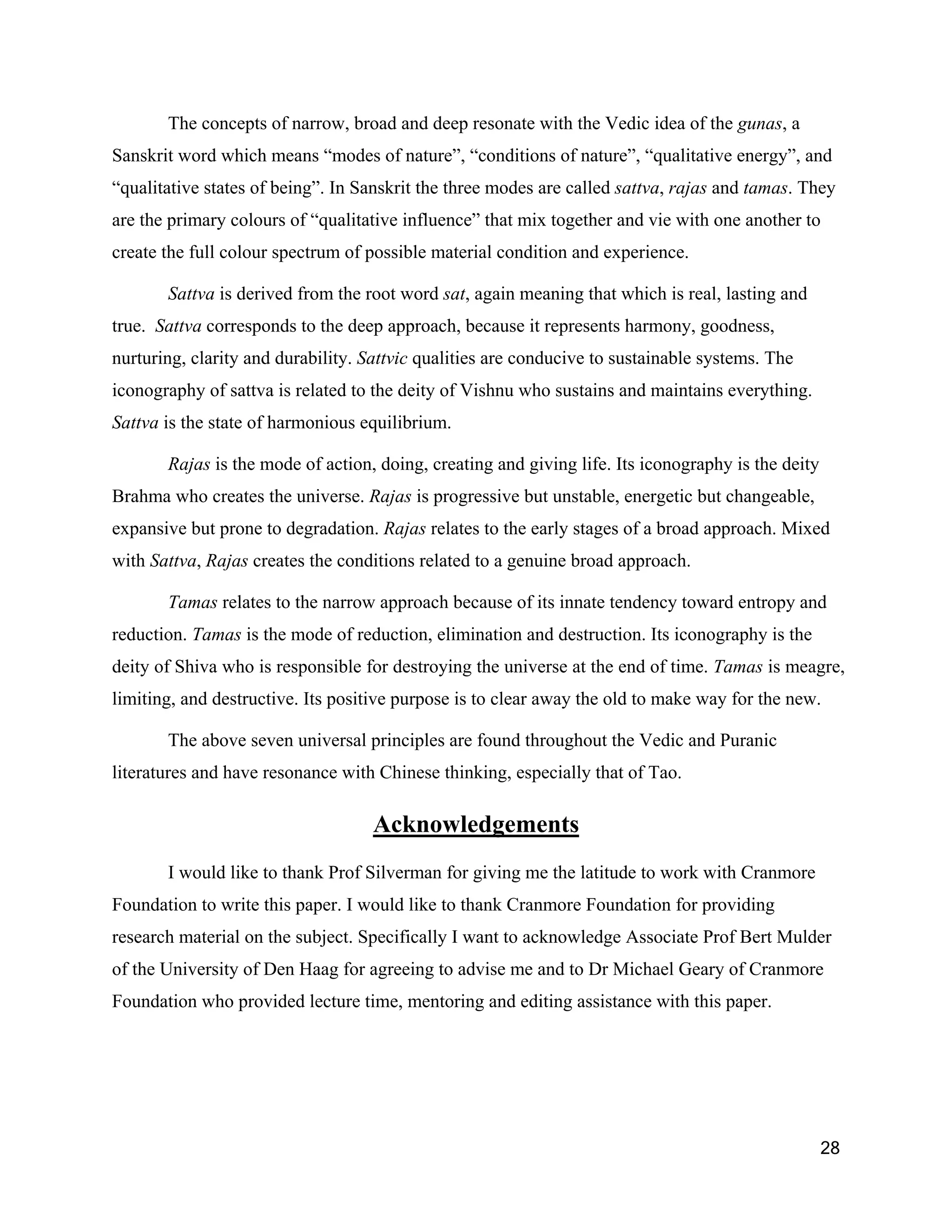
![Bibliography
Google Company. (n.d.). Google Corporate Website. Retrieved on May 3, 2011 from
http://www.google.com/corporate
Eliade, Mircea (1954). The Myth of the Eternal Return. Arkana Publishing (Penguin)
Haque, U. (2008). How Apple and Google dominate. Harvard Business Review. Retrieved on
May 3, 2011 from http://blogs.hbr.org/haque/2008/03/how_apple_and_google_dominate.html
Hart, S.L. (2005). Capitalism at the Crossroads. Upper Saddle River, NJ: Wharton School
Publishing.
Hart, S.L. & Milstein, M.B. (2003). Creating sustainable value. Academy of Management
Executive, 17(2), 56-69.
Haque, U. (2010). The new capitalist manifesto: building a disruptively better business
[Kindle version]. Retrieved April 25, 2011, from http://www.amazon.com
Kennicott, Philip. (2008). Daniel Pink and the economic model of creativity. The Washington
Post Website. Retrieve May 18, 2011, from http://www.washingtonpost.com/wp-
dyn/content/article/2008/04/01/AR2008040102435.html
Lazarus, R. (2009). Super wicked problems and climate change: restraining the present to
liberate the future. Cornell Law Review, 94, 1153-1234. Retrieved April 20, 2011,
from http://www.law.georgetown.edu
Lyer, B. & Davenport, T. (2008). Reverse engineering Google’s innovation machine.
Harvard Business Review. Retrieved April 25, 2011, from
http://hbr.org/2008/04/reverse-engineering-googles-innovation-machine/ar/1
McDonough, W. & Braungart, M. (2001). The next industrial revolution. Eco-effectiveness.
Greenleaf Publishing. Retrieved April 30, 2011, from http://www.sustreport.org
Nonaka, Ikujiro & Takeuchi, Hirotaka. (2011). The Bid Idea: The Wise Leader. Harvard
Business Review. Retrieved on May 15, 2011 from
29](https://image.slidesharecdn.com/valuesforvaluecreation-120509054644-phpapp01/75/Values-for-Value-Creation-29-2048.jpg)
![http://hbr.org/2011/05/the-big-idea-the-wise-leader/
Nunes, P. & Breene, T. (2011). Apple goes to slow to win. Harvard Business Review.
Retrieved on May 3, 2011 from http://blogs.hbr.org/cs/2011/03/apple_goes_slow.html
Porter, M. E. & Kramer, M. R. (2011, January-February). The big idea: creating shared value.
Harvard Business Review. Retrieved April 25, 2011, from http://hbr.org/2011/01/the-
big-idea-creating-shared-value/ar/1
Rittel, H. & Webber, M. (1973). Dilemmas in a general theory of planning. Policy Sciences,
4, 155-169. Retrieved April 25, 2011, from http://www.uctc.net
Savitz, A.W. & Weber, K. (2006). The triple bottom line. San Francisco, CA: Jossey-Bass.
Sisodia, Wolfe, & Sheth, J. N. (2007). Firms of endearment: how world-class companies
profit from passion and purpose [Kindle version]. Retrieved April 30, 2011, from
http://www.amazon.com
Swami, AC Bhaktivedanta. (1969). Sri Isopanisad. BBT Press
Thomke, S. & Feinberg, B. (2009). Design thinking and innovation at apple. Harvard
Business Review. Retrieved on May 3, 2011 from http://hbr.org/product/design-
thinking-and-innovation-at-apple/an/609066-PDF-ENG
Treehugger. (2008). Biomimicry course: learn about the amazing potential of design inspired by
nature. Take Action. Retrieved on May 15, 2011 from
http://www.treehugger.com/files/2008/09/biomimicry-course-schumacher-college.php
Weil, Z. (2009). Most good, least harm: a simple principle for a better world and meaningful
life. Zoe Weil Website. Retrieved May 9, 2011, from http://zoeweil.com/zoes-
books/most-good-least-harm
Yoffi, D. B. & Slind, M. L. (2008). Apple Inc., 2008. Harvard Business Review. Retrieved
March 30, 2011, from http://hbr.org/product/apple-inc-2008/an/708480-PDF-ENG
30](https://image.slidesharecdn.com/valuesforvaluecreation-120509054644-phpapp01/75/Values-for-Value-Creation-30-2048.jpg)